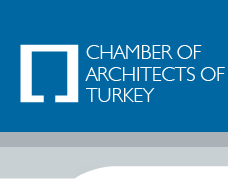Public Responsibilities | |
| PUBLIC RESPONSIBILITIES | |
|
In line with the general humanitarian and social mission of architecture and with the “public obligations” it has acquired from the Constitution and laws, CAT has been an institution of opinions and struggles emerging from the inseparable bond between architecture and the rights of the public in terms of cities, environment and culture. CAT endeavors to solve related problems and to eliminate objectionable practices in the light of the principles of architecture with its central, branch and representative office network. The Chamber is especially efficient in brings law suits against the development decisions and practices which are not compatible with the interest of cities, society and country. Since there is a direct relationship between such endeavors of CAT and a general improvement of architectural environment, all work run with social responsibility are also important for practicing the profession in a way that protects environmental and cultural values in terms of public benefit. Hence, social and artistic targets without making concessions have been the major policy of CAT, and this policy is also pursued in all its units. Commitment to Human Rights, Democracy and Peace The universal philosophy of architecture connected with human, environmental and social rights, which forms a basis for the Chamber’s policies, makes it an obligation that CAT, as a professional institution striving towards public interests, is also sensitive to related general policies. This is because national and global policies whose results are against human rights and benefit of cities are also factors that impede the realization of architecture in line with the above mentioned targets. Therefore, while CAT defends professional principles and general objectives of architecture, it is also an effective advocate of human rights, democracy, national interests and peace, which are interrelated principles and aims of architecture. The fact that architects are “intellectuals” of a society who are acquainted with art and creativity has caused such endeavors to become a traditional attitude of the Chamber. Legal Work / Protecting Cities and Environment CAT continues the most intense work in the field of law both to protect the rights and interests of architects and to protect architectural, urban, cultural and environmental rights of the society. The lawsuits initiated by the Chamber in the name of architects and public have contributed considerably to the benefits of the society to live in a healthy architectural and natural environment, rich in values, and has led to formation of various legal interpretations. Currently, other non-governmental organizations also benefit from this experience, which is preventing approaches and practices that induce urban and environmental problems through legal action. Social responsibility is not the only reason for this focus on legal matters. The restricted legal supervision and competence of CAT from these issues, especially in the processes related to urban construction laws is another reason for seeking input through court action. Consequently, “adjudicatory supervision” is most of the time the only alternative against decisions and practices of architectural and urban planning principles. CAT also contributes to the preparation of draft laws and legal regulations prepared by other institutions which are related to the spatial and architectural policies and seeks that such arrangements take public interest into consideration Scientific and Theoretical Activities Another important sphere of action of CAT within the framework of professional and social responsibilities is scientific and theoretical meetings and the publications which follow. The headquarters, branches and office representatives intensely organize symposiums, panel discussions and forums on national and local problems to contribute to the flow of information on issues to be investigated and discussed, development of ideas and production of solutions. These activities are realized with participation from public and private sectors and academic assessments and serve as far reaching education opportunities on architecture, urbanization, environment and culture with many of them producing publications. Hence, Chamber of Architects does not only contribute to the production of knowledge, but also to its dissemination Bu icerik 2328 defa görüntülenmiştir.
|








